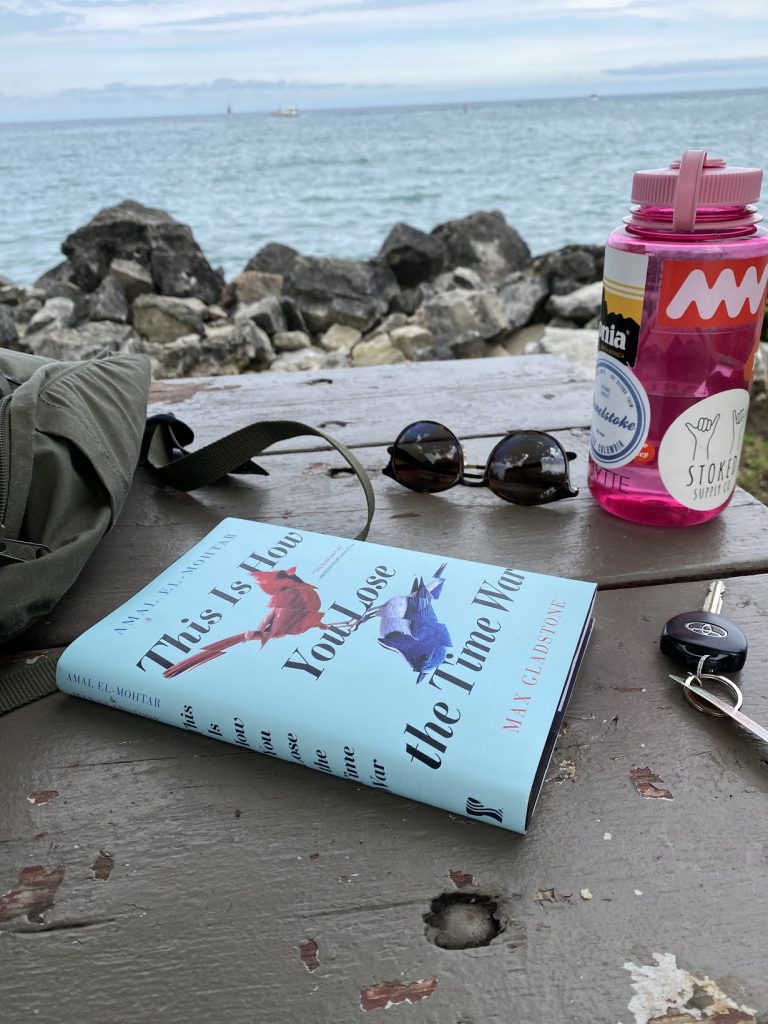Featuring Octavia Butler, time travel, and graphic novels!
Avec Octavia Butler, des romans graphiques et un voyage à travers le temps!
The Ten Thousand Doors of January
By Ila Ghoshal

Alix E. Harrow’s debut novel, The Ten Thousand Doors of January, takes you on a journey through multiple worlds, starting with early 20thcentury New England. January Scaller lives in a mansion full of strange artifacts with her guardian, Cornelius Locke, while her father goes on work expeditions all over the world for Locke and the New England Archeological Society. One day, while looking through the artifacts, she finds a book titled the Ten Thousand Doors in a chest. Believing the book is meant for her, January reads the story of a young woman from the South who meets a mysterious boy from another world. On her 18th birthday, she realizes that Locke and the Archeological Society are not what they seem, and she is forced to flee. While on the run with her friends Samuel and Jane, January learns that she can create doors and travel to different worlds. Over the course of this novel, we learn how January’s story intertwines with the one in the Ten Thousand Doors.
The novel covers a variety of issues including race, class, and gender. Though Harrow’s writing is beautiful, the book’s commentary was very obvious, in a way reminiscent of a lot of YA fiction. That being said, this novel will be entertaining and accessible to readers who aren’t too familiar with fantasy. I would recommend this book to fans of YA or to anyone looking for some light, well-written fantasy.
La Parabole des Talents
Par Francesca Robitaille

La conclusion de la série Parabole d’Octavia Butler apporte un ton très différent de son précurseur, La Parabole du Semeur. Dans Talents, Olamina est établie dans la communauté qu’elle a fondée et qu’elle fait grandir. Les problèmes affrontés dans le premier tome sont toujours présents, mais on peut voir ce qui est advenu du monde au niveau national. Un politicien extrémiste gagne aux élections avec un discours qui incite la population à devenir de « vrais Américains » et de se débarrasser de tous ceux qui n’en sont pas. Bien que les thèmes du roman s’approchent beaucoup de la réalité par moments, le ton reflète les nouveaux enjeux familiaux et politiques auxquels Olamina fait face. À travers le journal de sa fille, on voit les deux côtés des sacrifices qu’elle fait pour sa communauté. Ce récit met en l’avant le développement du caractère d’Olamina à travers des fautes qui n’étaient pas aussi centrales à son histoire dans Semeur.
Je vois des similarités entre ces tomes et les œuvres de Harper Lee. Non seulement les séries devaient-elles être chacune un roman, mais le premier raconte une histoire de maturité et le second apporte des nuances plus complexes aux personnages et à leurs choix. Si vous êtes en mesure de faire face aux similarités politiques des quatre dernières années, je vous recommande fortement la série de Butler.
This Is How You Lose the Time War:
By Francesca Robitaille

This short epistolary novella from Amal El-Mothar and Max Gladstone tells the tale of two time-travelling agents on opposing sides of the time war as they fight each other to try to sway the time war to their side’s favour. However, as they continuously meet across the different strains of time, they begin interacting with each other through smuggled letters. While Red and Blue, the two agents, constantly try to one-up each other, they begin to learn about and care for each other through their correspondence. Throughout their missions, their relationship grows and blossoms beautifully, while never losing its competitive edge.
Despite its short length, this story is rich and complex, bringing together a fully-developed world and characters. The pages and the writing are filled with love, grace, and humanity, all told through poetic language. The alternating perspectives and lyrical tone kept me hooked, and I had finished reading it barely a day later. The story was so beautifully written that I wish I could forget the whole thing, just to be able to experience it again for the first time. It was easily my favourite speculative fiction read of last year, and one I’ve been recommending to people ever since. The bittersweet ending brought tears to my eyes, but don’t let that put you off, I wouldn’t change a thing about this story, and recommend it to anyone looking for something beautiful to read.
Aliss en BD, un trip séquentiel :
Par Kai Ming Wang
Dans le but de souligner les 20 ans de son roman Aliss, Patrick Senécal a collaboré avec l’artiste Jeik Dion afin de nous proposer cette fois-ci de redécouvrir l’œuvre sous une toute nouvelle forme: celle d’un roman graphique.

À travers les quelque 200 pages illustrées, nous sommes, une fois de plus, invités à suivre Aliss dans sa quête d’aventure et de liberté et à assister, depuis les premières loges, à sa folle descente aux enfers dans un quartier où tous les vices sont permis.
Avec une palette principalement noire et blanche, le rendu visuel de Jeik Dion épouse parfaitement l’univers déstabilisant et macabre de cette adaptation très sombre de l’univers de Lewis Carroll. Le style éclaté et désordonné des planches s’ajoute aux couleurs ternes de la palette choisie, et est bien contrasté par les rares accents de rouge qui sont parsemés à travers l’oeuvre. Le résultat livre une version d’Aliss en bande dessinée qui est, non pas un remplacement du roman original de l’auteur, mais plutôt une version abrégée riche en émotions. Cette dernière s’avère être un excellent supplément pour les grands amateurs et amatrices de ce « Wonderland » décadent, ou pour ceux qui souhaitent y retourner une fois de plus…

